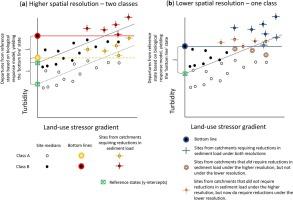Environmental Science & Policy ( IF 4.9 ) Pub Date : 2021-08-03 , DOI: 10.1016/j.envsci.2021.07.026 Rick J. Stoffels 1 , Paul A. Franklin 2 , Stephen R. Fragaszy 3 , Doug J. Booker 1 , Joanne E. Clapcott 4 , Ton H. Snelder 5 , Annika Wagenhoff 4 , Chris W. Hickey 2

|
There is growing recognition that multiple forms of uncertainty influence policy reform, but we need case studies illustrating how uncertainties influence reform, and strategies used to manage uncertainties in practice. We present a case study of how science was generated and incorporated into national water policy. We estimated turbidity (suspended fine sediment) reference states throughout the river network of New Zealand. A key decision-problem was: how region-specific should reference states be? We developed classifications of the national river network that grouped rivers with similar turbidity regimes into classes at four spatial resolutions. Choosing a classification was complicated by ontological uncertainties. Scientific actors framed these ontological uncertainties in different ways, introducing framing uncertainties (‘ambiguities’) into the decision-making process. Well-established statistical techniques were employed to objectively identify the most parsimonious classification, but those techniques had little impact on decision-making. Reframing ontological uncertainties in terms of risks to management objectives was required to reconcile divergent frames, and showed that the classification with the highest resolution was the most credible option. Nonetheless, local governments highlighted that the most credible classification was not the most relevant or legitimate one in light of implementation constraints. The final decision was made against a backdrop of ambiguities, was partially subjective, and balanced trade-offs among credibility, relevance and legitimacy. Looking ahead, ambiguities could be reduced by framing decision problems in terms of risks to management objectives. A barrier to doing this is the short duration of policy windows, so translational science must take place when such windows are shut.
中文翻译:

不确定性的多重框架塑造了水政策改革过程中参考状态的采用
人们越来越认识到多种形式的不确定性会影响政策改革,但我们需要通过案例研究来说明不确定性如何影响改革,以及在实践中管理不确定性的策略。我们提供了一个案例研究,说明科学是如何产生并将其纳入国家水政策的。我们估计了整个新西兰河网的浊度(悬浮细粒沉积物)参考状态。一个关键的决策问题是:参考状态应该如何特定于区域?我们开发了国家河流网络的分类,将具有相似浊度状况的河流分为四个空间分辨率的类别。由于本体论的不确定性,选择分类很复杂。科学参与者以不同的方式构建这些本体论的不确定性,在决策过程中引入框架不确定性(“歧义”)。成熟的统计技术被用来客观地确定最简洁的分类,但这些技术对决策几乎没有影响。需要根据管理目标的风险重新构建本体论的不确定性,以协调不同的框架,并表明具有最高分辨率的分类是最可靠的选择。尽管如此,地方政府强调,鉴于实施限制,最可信的分类并不是最相关或最合法的分类。最终决定是在模棱两可的背景下做出的,部分是主观的,并且在可信度、相关性和合法性之间进行了权衡。展望未来,通过根据管理目标的风险来确定决策问题,可以减少歧义。这样做的一个障碍是政策窗口的持续时间很短,因此当这些窗口关闭时,必须进行转化科学。











































 京公网安备 11010802027423号
京公网安备 11010802027423号